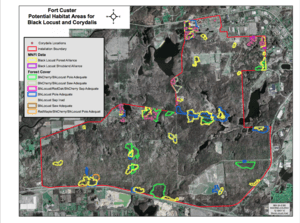Yellow fumewort facts for kids
Quick facts for kids Yellow fumewort |
|
|---|---|
 |
|
| Scientific classification | |
| Genus: |
Corydalis
|
| Species: |
flavula
|
Corydalis flavula (yellow fumewort, yellow harlequin, fume-root, yellow fumitory; syn. Capnoides flavulum (Raf.) Kuntze, Fumaria flavula Raf.) is an herbaceous perennial plant native to the eastern United States. Its natural habitat is open woods and slopes.
Status and phenology
Threats
Corydalis flavula (yellow fumewort) can be found throughout most of the eastern half of the US and also parts of Canada. It is a pioneer species that requires disturbance to thrive. Disturbance (mostly in the form of flooding as it is a floodplain species) helps to keep the overarching canopy at the right density for its light requirements. Because of this requirement it is threatened primarily due to human land use which often results in conversion of habitat to mowed lawns and managed streams and rivers, removing the disturbance and canopy the plant requires.
Michigan
Corydalis flavula is a state threatened plant in Michigan. It occurs in floodplains under relatively open forest canopy. It is at the north end of its range in the US in Michigan, helping to explain why it is threatened in Michigan and only one other state (Connecticut) in its range. Current focused research on the plant at one of its strongholds shows that it can adapt to some other habitats that mimic the disturbance and canopy cover of a floodplain forest.
Given that the plant is in the north end of its range, and the climate change impacts will increase temperatures and flooding due to more intense and frequent rain events in Michigan in the next 50 years, the plant has a good chance of flourishing under these conditions. The National Climate Assessment predicts higher temperatures in all seasons in Michigan (summer differences from current will be larger than winter differences). It also predicts that rain events will be increasingly concentrated in the spring and fall seasons and in fewer, heavier bursts (1-3 inches average), which will increase flooding in all categories of streams.
At Ft. Custer Training Center (FCTC) in southwest Michigan, C. flavula was found when an armory was being constructed in 1995. This led to Michigan Department of Military and Veterans Affairs to seek a permit from the Michigan Department of Natural Resources for the take of the plant during the construction of the building. The permit required ten years of monitoring along a transect in a black locust dominated area near the armory construction. At the end of the ten years it was determined that further surveys needed to be conducted elsewhere on the installation, not only because it was apparent the plant occurred elsewhere on the 7,500 acre property, but also because there was the threat of more take due to new construction in 2012. The embedded map shows the potential habitat considered viable in the 2010 consideration of where to survey to manage the construction threat in 2012.
These surveys of the property found C. flavula in extensive areas elsewhere on the installation, some areas having healthy populations across 10s of acres.
The management of the species to increase its population is unclear. However, the work being done at FCTC is showing that disturbance is key. Prescribed fire opens up the understory and seems to promote a flush either the year of the burn or the year after, depending on conditions and seasonality of the burn. Other disturbance events that have promoted it on FCTC lands are large soil erosion events near an existing population, and in one instance a timber harvest. It has also become clear that this plant is not exclusively dependent on floodplains, their soil, their disturbance regime and the overstory particular to a floodplain. Indeed, the plant has been found to flourish under the black locusts (Robinia pseudoacacia) (illustrated by embedded map). Research since the map was developed has found extensive populations in many areas far from a floodplain but very much in a disturbance based system. Black locust as a species is also a pioneer and dependent upon disturbance in its early years. The tree emits an allelopathic chemical that impacts many plants and generally promotes a relatively barren understory. For reasons not yet understood, pale fumewort has taken to black locust understory quite well.
Historical uses
Corydalis flavula belongs to the Ranunculales order, an order of plants that often contains many alkaloids that make plants distasteful to toxic. Early use by Native Americans involved inhalation of the smoke of a charring plant.


